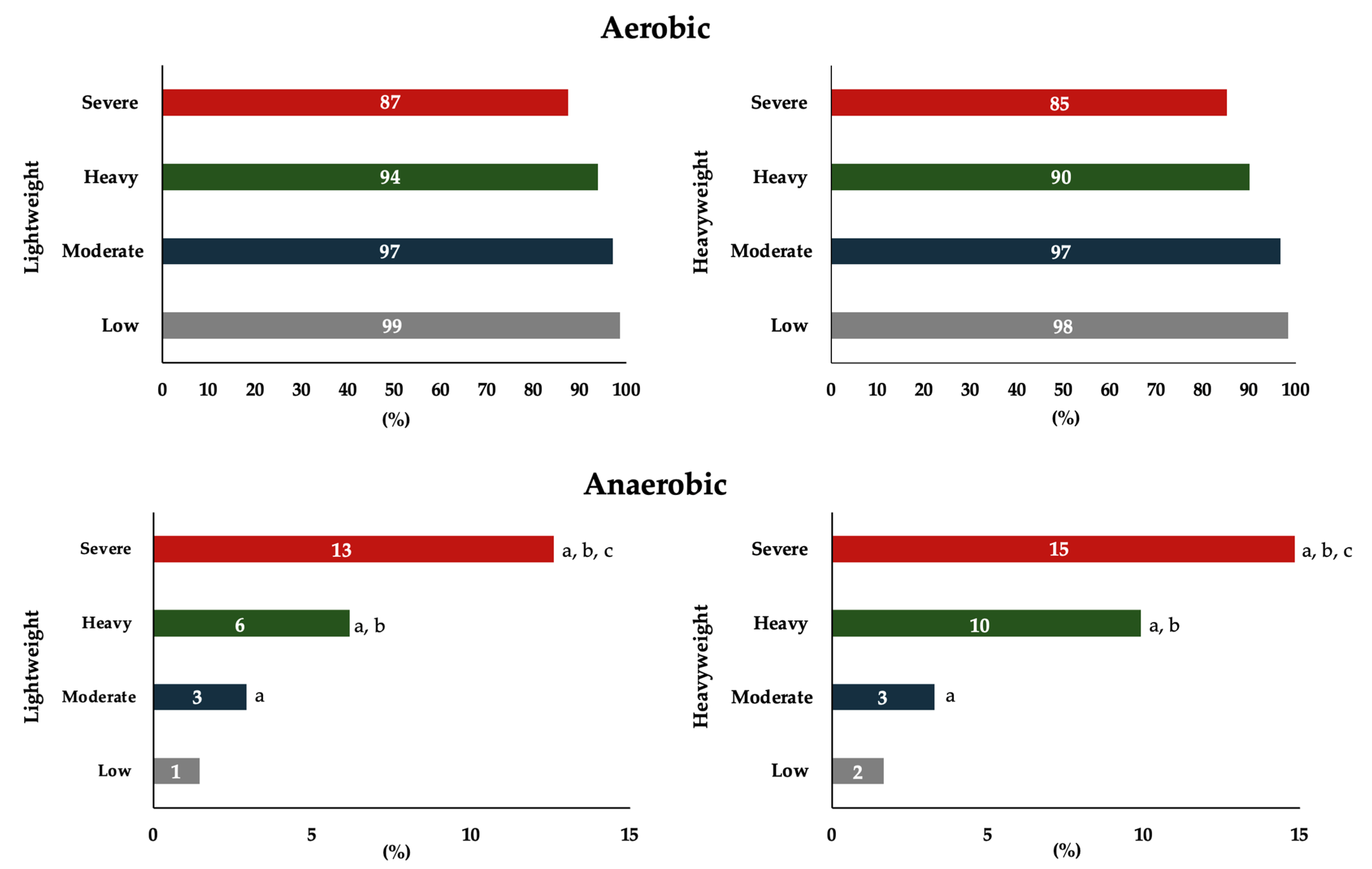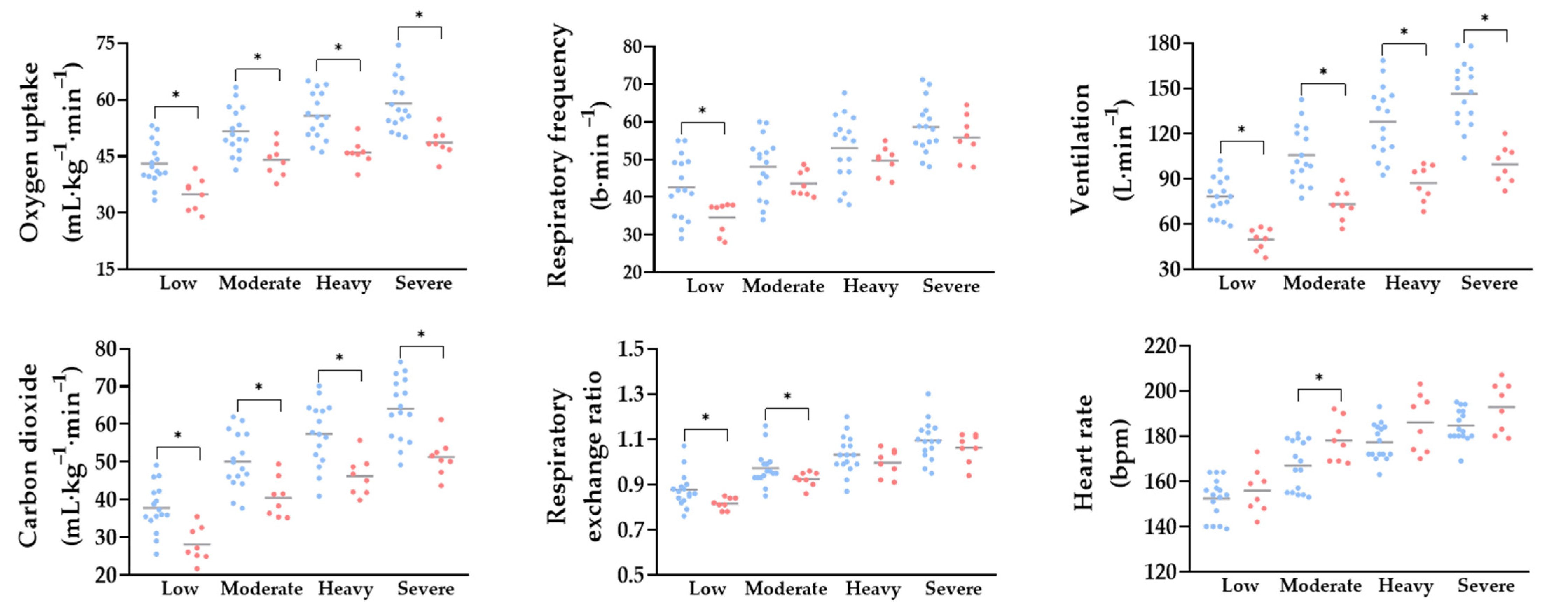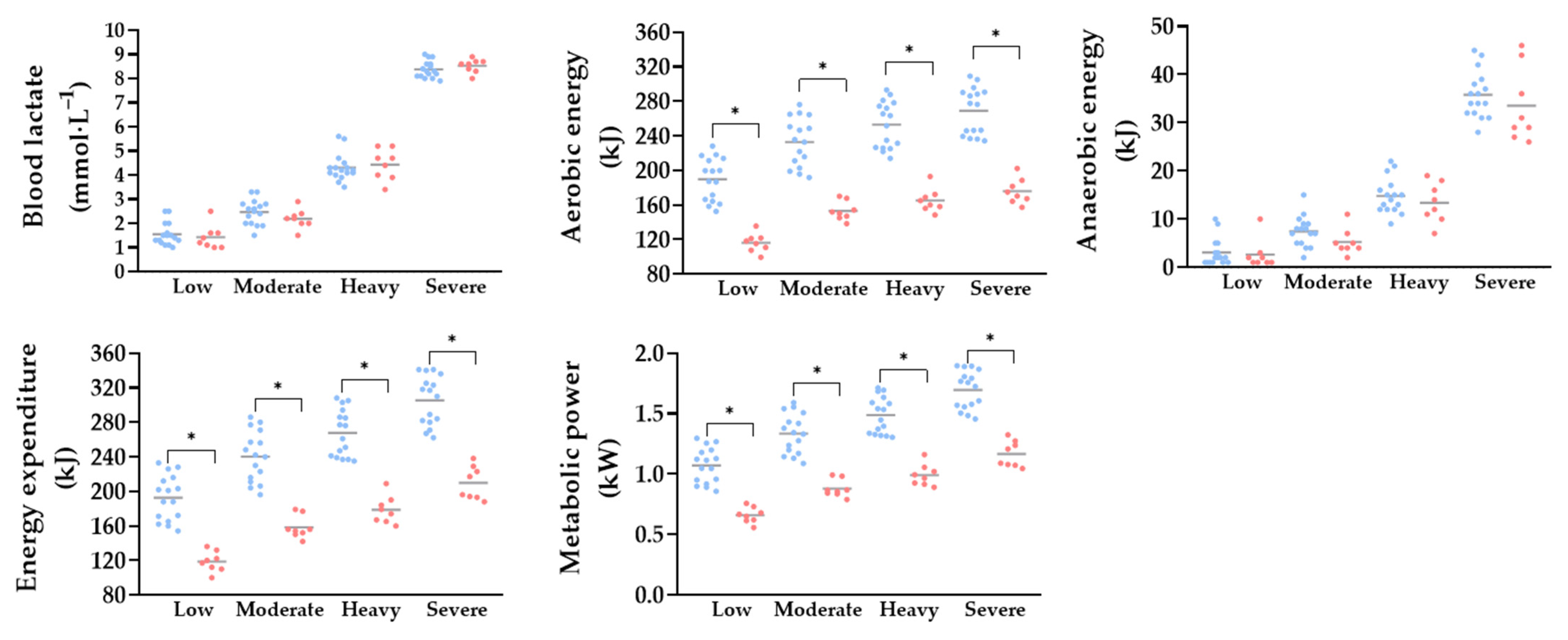Physiological Demands Across Exercise Intensity Domains in Rowing: Implications of Weight Category and Sex Differences
Abstract
1. Introduction
2. Materials and Methods
2.1. Study Design
2.2. Participants
2.3. Procedure
2.4. Statistical Analysis
3. Results
4. Discussion
Limitations, Future Directions and Practical Applications
5. Conclusions
Author Contributions
Funding
Institutional Review Board Statement
Informed Consent Statement
Data Availability Statement
Acknowledgments
Conflicts of Interest
References
- Holt, A.C.; Siegel, R.; Ball, K.; Hopkins, W.G.; Aughey, R.J. Prediction of 2000-m on-water rowing performance with measures derived from instrumented boats. Scand. J. Med. Sci. Sports 2022, 32, 710–719. [Google Scholar] [CrossRef]
- Mäestu, J.; Lelle, R.; Mäestu, E.; Pind, R.; Vahtra, E.; Purge, P.; Mikulic, P. Long-Term Rowing Performance Development in Male Olympic and World Championship Medal Winners Compared With Nonmedalists. J. Strength Cond. Res. 2023, 37, e521–e526. [Google Scholar] [CrossRef]
- Blervaque, L.; Bowen, M.; Chatel, B.; Corbex, E.; Dalmais, E.; Messonnier, L.A. Is the Energy Cost of Rowing a Determinant Factor of Performance in Elite Oarsmen? Front. Physiol. 2022, 13, 827932. [Google Scholar] [CrossRef] [PubMed]
- Winkert, K.; Steinacker, J.M.; Koehler, K.; Treff, G. High Energetic Demand of Elite Rowing—Implications for Training and Nutrition. Front. Physiol. 2022, 13, 829757. [Google Scholar] [CrossRef]
- Cardoso, R.; Rios, M.; Fonseca, P.; Leão, J.; Cardoso, F.; Abraldes, J.A.A.; Gomes, B.B.; Vilas-Boas, J.P.; Fernandes, R.J. Assessment of Angular and Straight Linear Rowing Ergometers at Different Intensities of Exercise. Sensors 2024, 24, 5686. [Google Scholar] [CrossRef] [PubMed]
- Penichet-Tomas, A.; Jimenez-Olmedo, J.M.; Pueo, B.; Olaya-Cuartero, J. Physiological and Mechanical Responses to a Graded Exercise Test in Traditional Rowing. Int. J. Environ. Res. Public Health 2023, 20, 3664. [Google Scholar] [CrossRef] [PubMed]
- Fernandes, R.J.; Carvalho, D.D.; Figueiredo, P. Training zones in competitive swimming: A biophysical approach. Front. Sports Act. Living 2024, 6, 1363730. [Google Scholar] [CrossRef]
- Hill, D.W.; Halcomb, J.N.; Stevens, E.C. Oxygen uptake kinetics during severe intensity running and cycling. Eur. J. Appl. Physiol. 2003, 89, 612–618. [Google Scholar] [CrossRef]
- Lopes, A.M.; Rios, M.; Beleza, J.; Carvalho, D.D.; Monteiro, S.; Montanha, T.; Martins, S.; Guimarães, J.T.; Fernandes, R.J.; Magalhães, J.; et al. Adding protein to a carbohydrate pre-exercise beverage does not influence running performance and metabolism. J. Sports Med. Phys. Fit. 2023, 63, 53–59. [Google Scholar] [CrossRef]
- Cardoso, R.; Rios, M.; Cardoso, F.; Bouicher, S.; Abraldes, J.A.; Gomes, B.B.; Vilas-Boas, J.P.; Fernandes, R.J. Randall Foils Versus Big Blades: Comparative Analysis in On-Water Sprint Rowing. Int. J. Sports Physiol. Perform. 2025, 20, 678–683. [Google Scholar] [CrossRef]
- Cerasola, D.; Bellafiore, M.; Cataldo, A.; Zangla, D.; Bianco, A.; Proia, P.; Traina, M.; Palma, A.; Capranica, L. Predicting the 2000-m Rowing Ergometer Performance from Anthropometric, Maximal Oxygen Uptake and 60-s Mean Power Variables in National Level Young Rowers. J. Hum. Kinet. 2020, 75, 77–83. [Google Scholar] [CrossRef]
- Cataldo, A.; Cerasola, D.; Russo, G.; Zangla, D.; Traina, M. Mean power during 20 sec all-out test to predict 2000 m rowing ergometer performance in national level young rowers. J. Sports Med. Phys. Fit. 2015, 55, 872–877. [Google Scholar]
- Sousa, A.; Figueiredo, P.; Pendergast, D.; Kjendlie, P.L.; Vilas-Boas, J.P.; Fernandes, R.J. Critical evaluation of oxygen-uptake assessment in swimming. Int. J. Sports Physiol. Perform. 2014, 9, 190–202. [Google Scholar] [CrossRef]
- Jones, A.M.; Burnley, M.; Black, M.I.; Poole, D.C.; Vanhatalo, A. The maximal metabolic steady state: Redefining the ‘gold standard’. Physiol. Rep. 2019, 7, e14098. [Google Scholar] [CrossRef]
- Purge, P.; Jurimae, J.; Jurimae, T. Hormonal and psychological adaptation in elite male rowers during prolonged training. J. Sports Sci. 2006, 24, 1075–1082. [Google Scholar] [CrossRef] [PubMed]
- Wang, Z.; Wang, J. The effects of high-intensity interval training versus moderate-intensity continuous training on athletes’ aerobic endurance performance parameters. Eur. J. Appl. Physiol. 2024, 124, 2235–2249. [Google Scholar] [CrossRef] [PubMed]
- Podstawski, R.; Borysławski, K.; Katona, Z.; Alföldi, Z.; Boraczyński, M.; Jaszczur-Nowicki, J.; Gronek, P. Sex Differences in Anthropometric and Physiological Profiles of Hungarian Rowers of Different Ages. Int. J. Environ. Res. Public Health 2022, 19, 8115. [Google Scholar] [CrossRef]
- Keenan, K.G.; Senefeld, J.W.; Hunter, S.K. Girls in the boat: Sex differences in rowing performance and participation. PLoS ONE 2018, 13, e0191504. [Google Scholar] [CrossRef]
- Kerr, D.A.; Ross, W.D.; Norton, K.; Hume, P.; Kagawa, M.; Ackland, T.R. Olympic lightweight and open-class rowers possess distinctive physical and proportionality characteristics. J. Sports Sci. 2007, 25, 43–53. [Google Scholar] [CrossRef]
- Bourdin, M.; Messonnier, L.; Hager, J.P.; Lacour, J.R. Peak power output predicts rowing ergometer performance in elite male rowers. Int. J. Sports Med. 2004, 25, 368–373. [Google Scholar] [CrossRef]
- Doyle, M.M.; Lyttle, A.; Elliott, B. Comparison of force-related performance indicators between heavyweight and lightweight rowers. Sports Biomech. 2010, 9, 178–192. [Google Scholar] [CrossRef] [PubMed]
- Messonnier, L.; Aranda-Berthouze, S.E.; Bourdin, M.; Bredel, Y.; Lacour, J.R. Rowing performance and estimated training load. Int. J. Sports Med. 2005, 26, 376–382. [Google Scholar] [CrossRef] [PubMed]
- Tran, J.; Rice, A.; Main, L.; Gastin, P. Development and Implementation of a Novel Measure for Quantifying Training Loads in Rowing: The T2minute Method. J. Strength Cond. Res. 2013, 28, 1172–1180. [Google Scholar] [CrossRef] [PubMed]
- Cardoso, R.; Rios, M.; Cardoso, F.; Fonseca, P.; Ferreira, F.A.; Abraldes, J.A.; Gomes, B.B.; Vilas-Boas, J.P.; Fernandes, R.J. Physiological and Biomechanical Characteristics of Olympic and World-Class Rowers—Case Study. Appl. Sci. 2024, 14, 4273. [Google Scholar] [CrossRef]
- Zhang, Q. Gender Differences in Peak Blood Lactate Concentration and Blood Lactate Removal Following Strenuous Exercise. Master’s Thesis, Springfield College, Springfield , MA, USA, 1991. [Google Scholar]
- Hottenrott, L.; Möhle, M.; Ide, A.; Ketelhut, S.; Stoll, O.; Hottenrott, K. Recovery from different high-intensity interval training protocols: Comparing well-trained women and men. Sports 2021, 9, 34. [Google Scholar] [CrossRef]
- Jaworowski, A.; Porter, M.M.; Holmbäck, A.M.; Downham, D.; Lexell, J. Enzyme activities in the tibialis anterior muscle of young moderately active men and women: Relationship with body composition, muscle cross-sectional area and fibre type composition. Acta Physiol. Scand. 2002, 176, 215–225. [Google Scholar] [CrossRef]
- Howley, E.T.; Bassett, D.R., Jr.; Welch, H.G. Criteria for maximal oxygen uptake: Review and commentary. Med. Sci. Sports Exerc. 1995, 27, 1292–1301. [Google Scholar] [CrossRef]
- Rios, M.; Becker, K.M.; Monteiro, A.S.; Fonseca, P.; Pyne, D.B.; Reis, V.M.; Moreira-Gonçalves, D.; Fernandes, R.J. Effect of the Fran CrossFit Workout on Oxygen Uptake Kinetics, Energetics, and Postexercise Muscle Function in Trained CrossFitters. Int. J. Sports Physiol. Perform. 2024, 19, 299–306. [Google Scholar] [CrossRef]
- Zamparo, P.; Cortesi, M.; Gatta, G. The energy cost of swimming and its determinants. Eur. J. Appl. Physiol. 2020, 120, 41–66. [Google Scholar] [CrossRef]
- Rios, M.; Zacca, R.; Azevedo, R.; Fonseca, P.; Pyne, D.B.; Reis, V.M.; Moreira-Gonçalves, D.; Fernandes, R.J. Bioenergetic Analysis and Fatigue Assessment During the Fran Workout in Experienced Crossfitters. Int. J. Sports Physiol. Perform. 2023, 18, 786–792. [Google Scholar] [CrossRef]
- Gagnon, D.; Filipovic, M.; Munten, S.; Herzig, K.-H. Maximal Fat Oxidation: Comparison between Treadmill, Elliptical and Rowing Exercises. J. Sports Sci. Med. 2021, 20, 170–178. [Google Scholar] [CrossRef]
- Papadopoulou, Z.; Riganas, C.; Mandroukas, A.; Vrabas, I.; Mandroukas, K. Performance differences during a simulated all–out race and a VO2max incremental test between lightweight and heavyweight Greek rowers. Acta Univ. Carol. Kinanthropologica 2009, 45, 119–131. [Google Scholar]
- Rios, M.; Cardoso, R.; Reis, V.M.; Moreira-Gonçalves, D.; Pyne, D.B.; Fernandes, R.J. Sex-related differences in the acute physiological response to a high-intensity CrossFit® workout. Curr. Res. Physiol. 2025, 8, 100148. [Google Scholar] [CrossRef]
- Howden, E.J.; Perhonen, M.; Peshock, R.M.; Zhang, R.; Arbab-Zadeh, A.; Adams-Huet, B.; Levine, B.D. Females have a blunted cardiovascular response to one year of intensive supervised endurance training. J. Appl. Physiol. 2015, 119, 37–46. [Google Scholar] [CrossRef]
- Hill, D.W.; Smith, J.C. Gender difference in anaerobic capacity: Role of aerobic contribution. Br. J. Sports Med. 1993, 27, 45–48. [Google Scholar] [CrossRef] [PubMed]
- Held, S.; Rappelt, L.; Brockherde, J.; Donath, L. Reliability of the Maximal Lactate Accumulation Rate in Rowers. Int. J. Sports Med. 2024, 45, 238–244. [Google Scholar] [CrossRef] [PubMed]
- Volianitis, S.; Yoshiga, C.C.; Secher, N.H. The physiology of rowing with perspective on training and health. Eur. J. Appl. Physiol. 2020, 120, 1943–1963. [Google Scholar] [CrossRef] [PubMed]
- De Larochelambert, Q.; Del Vecchio, S.; Leroy, A.; Duncombe, S.L.; Toussaint, J.F.; Sedeaud, A. Body and Boat: Significance of Morphology on Elite Rowing Performance. Front. Sports Act. Living 2020, 2, 597676. [Google Scholar] [CrossRef]
- Stefani, R. The Power-to-Weight Relationships and Efficiency Improvements of Olympic Champions in Athletics, Swimming and Rowing. Int. J. Sports Sci. Coach. 2014, 9, 271–286. [Google Scholar] [CrossRef]
- Ingham, S.A.; Whyte, G.P.; Jones, K.; Nevill, A.M. Determinants of 2,000 m rowing ergometer performance in elite rowers. Eur. J. Appl. Physiol. 2002, 88, 243–246. [Google Scholar] [CrossRef]
- Mikulic, P. Anthropometric and physiological profiles of rowers of varying ages and ranks. J. Kinesiol. 2008, 40, 80–88. [Google Scholar]
- Steinacker, J.M. Physiological aspects of training in rowing. Int. J. Sports Med. 1993, 14, S3–S10. [Google Scholar]
- Burge, C.M.; Carey, M.F.; Payne, W.R. Rowing performance, fluid balance, and metabolic function following dehydration and rehydration. Med. Sci. Sports Exerc. 1993, 25, 1358–1364. [Google Scholar] [CrossRef]
- Beneke, R.; Leithauser, R.M.; Hutler, M. Dependence of the maximal lactate steady state on the motor pattern of exercise. Br. J. Sports Med. 2001, 35, 192–196. [Google Scholar] [CrossRef] [PubMed]
- Hagerman, F.C. Applied physiology of rowing. Sports Med. 1984, 1, 303–326. [Google Scholar] [CrossRef] [PubMed]
- Rascon, J.; Trujillo, E.; Morales-AcuÑa, F.; Gurovich, A.N. Differences between Males and Females in Determining Exercise Intensity. Int. J. Exerc. Sci. 2020, 13, 1305–1316. [Google Scholar] [CrossRef] [PubMed]
- Schünemann, F.; Park, S.-Y.; Wawer, C.; Theis, C.; Yang, W.-H.; Gehlert, S. Diagnostics of νLa.max and Glycolytic Energy Contribution Indicate Individual Characteristics of Anaerobic Glycolytic Energy Metabolism Contributing to Rowing Performance. Metabolites 2023, 13, 317. [Google Scholar] [CrossRef]
- Yoshiga, C.C.; Higuchi, M. Rowing performance of female and male rowers. Scand. J. Med. Sci. Sports 2003, 13, 317–321. [Google Scholar] [CrossRef]



| Variables | Lightweight n = 12 | Heavyweight n = 12 | Males n = 16 | Females n = 8 * |
|---|---|---|---|---|
| Age (years) | 24.83 ± 9.82 | 23.92 ± 8.04 | 26.40 ± 9.45 | 20.13 ± 6.64 |
| Height (cm) | 173.94 ± 6.92 | 177.53 ± 9.95 | 179.30 ± 7.48 | 168.53 ± 6.39 |
| Body Mass (kg) | 75.99 ± 21.26 | 80.41 ± 11.34 | 80.39 ± 9.19 | 74.43 ± 27.07 |
| Lean Mass (%) | 61.63 ± 20.28 | 57.63 ± 15.70 | 49.12 ± 14.28 | 39.09 ± 11.57 |
| Fat Mass (%) | 15.37 ± 8.62 | 14.80 ± 5.36 | 10.91 ± 2.97 | 22.87 ± 6.14 |
| Experience (years) | 9.14 ± 3.24 | 9.22 ± 2.44 | 10.43 ± 4.35 | 10.75 ± 0.46 |
| Variables | Low | Moderate | Heavy | Severe | ||||
|---|---|---|---|---|---|---|---|---|
| Lightweight | Heavyweight | Lightweight | Heavyweight | Lightweight | Heavyweight | Lightweight | Heavyweight | |
| Power (W) | 184.17 ± 44.81 † | 183.33 ± 54.33 † | 238.33 ± 52.54 a,† | 240.01 ± 58.31 a,† | 269.17 ± 55.34 a,b,† | 277.50 ± 61.07 a,b,† | 297.50 ± 57.54 a,b,c,† | 305.83 ± 63.45 a,b,c,† |
| Oxygen uptake (mL∙kg−1∙min–1) | 42.20 ± 6.21 † | 38.50 ± 6.43 † | 51.42 ± 6.95 a,† | 46.82 ± 5.92 a,† | 54.78 ± 7.17 a,b,† | 50.17 ± 6.55 a,b,† | 58.42 ± 8.62 a,b,c,† | 52.67 ± 6.07 a,b,c,† |
| Respiratory frequency (b∙min–1) | 42.35 ± 12.95 § | 37.20 ± 9.58 § | 44.97 ± 10.86 § | 45.56 ± 8.47 a,§ | 51.31 ± 9.84 a,b,§ | 50.62 ± 9.30 a,b,§ | 57.41 ± 11.38 a,b,c,§ | 56.68 ± 9.15 a,b,§ |
| Ventilation (L∙min–1) | 67.87 ± 16.98 † | 71.67 ± 19.29 † | 90.99 ± 21.14 a,† | 100.60 ± 24.75 a,† | 109.02 ± 24.56 a,b,† | 121.80 ± 30.75 a,b,† | 125.62 ± 27.93 a,b,c,† | 137.64 ± 30.59 a,b,c,† |
| Carbon dioxide (mL∙kg−1∙min–1) | 36.30 ± 7.64 § | 32.78 ± 7.04 § | 49.34 ± 8.39 a,§ | 44.51 ± 7.40 a,§ | 56.16 ± 9.28 a,b,§ | 51.17 ± 8.48 a,b,§ | 63.30 ± 10.07 a,b,c,§ | 56.35 ± 7.85 a,b,c,§ |
| Respiratory exchange ratio | 0.86 ± 0.09 † | 0.84 ± 0.06 † | 0.96 ± 0.09 a,† | 0.94 ± 0.07 a,† | 1.03 ± 0.08 a,b,† | 1.01 ± 0.08 a,b,† | 1.10 ± 0.09 a,b,c,† | 1.07 ± 0.08 a,b,c,† |
| Heart rate (bpm) | 154 ± 12 § | 149 ± 12 § | 171 ± 17 a,§ | 168 ± 13 a,§ | 178 ± 21 a,b,§ | 176 ± 14 a,b,§ | 184 ± 18 a,b,c,§ | 184 ± 13 a,b,c,§ |
| Blood lactate (mmol∙L–1) | 1.55 ± 0.77 # | 1.58 ± 0.51 # | 2.41 ± 0.71 a,# | 2.43 ± 0.43 a, # | 4.23 ± 1.19 a,b,# | 6.93 ± 8.12 a,b,c,# | 8.58 ± 1.86 a,b,c,# | 8.27 ± 3.42 a,b,c,# |
| Aerobic energy (kJ) | 163.24 ± 38.82 † | 170.34 ± 43.73 † | 203.08 ± 43.31 a,† | 212.13 ± 46.70 a,† | 218.15 ± 48.87 a,b,† | 229.03 ± 50.78 a,b,† | 234.15 ± 52.93 a,b,c,† | 241.59 ± 50.31 a,b,c,† |
| Anaerobic energy (kJ) | 2.25 ± 2.83 # | 3.16 ± 3.02 # | 6.08 ± 2.91 a,# | 7.36 ± 2.98 a,# | 13.86 ± 4.48 a,b,# | 29.64 ± 39.40 a,b,# | 32.54 ± 5.92 a,b,c,# | 41.25 ± 10.39 a,b,c,*,# |
| Energy expenditure (kJ) | 165.50 ± 37.01 † | 168.74 ± 43.64 † | 209.17 ± 42.27 † | 213.38 ± 46.92 a,† | 232.02 ± 44.96 | 254.16 ± 73.07 a,b,† | 266.69 ± 51.59 | 277.52 ± 51.23 a,b,c,† |
| Metabolic power (kW) | 0.92 ± 0.21 † | 0.96 ± 0.25 † | 1.16 ± 0.25 a,† | 1.22 ± 0.27 a,† | 1.19 ± 0.26 a,b,† | 1.44 ± 0.42 a,b,† | 1.48 ± 0.30 a,b,c,† | 1.57 ± 0.30 a,b,c,† |
Disclaimer/Publisher’s Note: The statements, opinions and data contained in all publications are solely those of the individual author(s) and contributor(s) and not of MDPI and/or the editor(s). MDPI and/or the editor(s) disclaim responsibility for any injury to people or property resulting from any ideas, methods, instructions or products referred to in the content. |
© 2025 by the authors. Licensee MDPI, Basel, Switzerland. This article is an open access article distributed under the terms and conditions of the Creative Commons Attribution (CC BY) license (https://creativecommons.org/licenses/by/4.0/).
Share and Cite
Rios, M.; Cardoso, R.; Monteiro, A.S.; Vilas-Boas, J.P.; Fernandes, R.J. Physiological Demands Across Exercise Intensity Domains in Rowing: Implications of Weight Category and Sex Differences. Sports 2025, 13, 245. https://doi.org/10.3390/sports13080245
Rios M, Cardoso R, Monteiro AS, Vilas-Boas JP, Fernandes RJ. Physiological Demands Across Exercise Intensity Domains in Rowing: Implications of Weight Category and Sex Differences. Sports. 2025; 13(8):245. https://doi.org/10.3390/sports13080245
Chicago/Turabian StyleRios, Manoel, Ricardo Cardoso, Ana Sofia Monteiro, João Paulo Vilas-Boas, and Ricardo J. Fernandes. 2025. "Physiological Demands Across Exercise Intensity Domains in Rowing: Implications of Weight Category and Sex Differences" Sports 13, no. 8: 245. https://doi.org/10.3390/sports13080245
APA StyleRios, M., Cardoso, R., Monteiro, A. S., Vilas-Boas, J. P., & Fernandes, R. J. (2025). Physiological Demands Across Exercise Intensity Domains in Rowing: Implications of Weight Category and Sex Differences. Sports, 13(8), 245. https://doi.org/10.3390/sports13080245









